
“It’s not a good idea to put your wife into a novel…not your latest wife, anyway.” – Norman Mailer
Have you ever used a real person as the basis for a character in one of your novels? Been tempted to? What’s the backstory on that?

 By Elaine Viets
By Elaine Viets
CAUTION: Pearl-clutching zone. This blog contains R-rated language. If you’re offended by off-color words, please don’t continue.
Hah. I knew you’d keep reading this.
When I was a kid, my mother would wash my mouth out with soap if I used bad language. I can tell you from personal experience, Dial soap does not taste good.
Now that I’m grown up, those same forbidden words are in the dictionary. Yes, sometimes I mourn the good old days, when no one dared to use these words in public. But we can’t go back.
So why am I writing about offensive words?
Because if we want to write realistic stories, that’s how some people talk.
When I lived in a rough neighborhood in Washington DC, I was approached by would-be purse thief. He didn’t say, “Madame, hand over your reticule, please.” He said, “Give me your money, bitch.” (He didn’t get it, but that’s another story.)
In our novels, offensive language can be in indication of character (or lack of), social status, and age. Younger people are more likely to use these words than older ones.
Here are some cuss words from the Merriam-Webster online dictionary.
 Badass. One word, no hyphen.
Badass. One word, no hyphen.
This is my favorite off-color word. Often used for men, lately it’s been describing strong women (see kickass). Gal Godot in Wonder Woman, Uma Thurman in Kill Bill, and Michelle Yeoh, in Crouching Tiger, Hidden Dragon, are all examples. Dania Gurira, the all-women army leader in Black Panther, is the epitome of badass.
Webster says badass can be an adjective and both usages are “chiefly US, informal and sometimes offensive.”
Badass means “ready to cause or get into trouble.” Or, “of formidable strength or skill” as in “a badass guitar player.”
As a noun, badass is “a person who is badass.”
Badassery. Noun, one word.
It means “the state or condition of being a badass.”
This example in the Village Voice would have had Mom buying a case of Dial.
“The Seattle quartet, hailed as godfathers of emo back when that word made you think of something other than ‘eyeliner,’ indulged the distorted guitar badassery of their grunge-era brethren …”
 Bitch. Noun.
Bitch. Noun.
We all know that bitch is a female dog. That’s excuse I used on Mom when she was brandishing that soap bar. She wasn’t fooled.
Like Webster, Mom knew that word was “informal and often offensive” and meant, “a malicious, spiteful, or overbearing woman.” It was also “a generalized term of abuse and disparagement for a woman.” And finally, “something that is extremely difficult, objectionable, or unpleasant.”
Or, as the novelist Harold Robbins wrote: “July and August were always a bitch in the subway.”
Bitch also means “complaint,” and is both a transitive and intransitive verb.
“They bitched up their lives.”
 SOB. Noun, capped with no periods.
SOB. Noun, capped with no periods.
Webster downgrades this cuss word to “slang, sometimes offensive” and gives this example: “. . .. A guy who brought two dozen roses to a first coffee date and told you he felt like the luckiest SOB on the planet in the first five minutes.”
 Asshat. Here’s a word that seems to be gaining in popularity in novels.
Asshat. Here’s a word that seems to be gaining in popularity in novels.
Webster says it’s a noun and “vulgar slang. A stupid, annoying, or detestable person.” See, asshole.
The first known use of this was in 1999. Then Webster has this odd “History and Etymology for asshat.”
“The seemingly nonsensical linking of ass and hat has a curious prehistory. Examples of the linkage can be found in dialogue lines from late-twentieth-century films: ‘Anyone found bipedal in five wears his ass for a hat!’ (addressed to the employees of a bank as the robbers leave, in Raising Arizona, 1987, script by Ethan and Joel Coen). . . .”
Webster wonders: “If we have been calling people assheads for almost 500 years now, why did it take so long for ass and hat to get together in similarly pejorative fashion? One reason may be that while ass lends itself well to the beginning of an opprobrious compound, hat leaves something to be desired in terms of mordant wit.”
Amen. Few of these words can be considered witty, and most are a blight on the language.
Now we get to the cuss words I really dislike.
 Asshole. A noun, “usually vulgar.”
Asshole. A noun, “usually vulgar.”
The first meaning is “anus,” but Webster also says it can mean “a stupid, annoying, or detestable person,” and “the least attractive or desirable part or area —used in phrases like asshole of the world.” This is an ancient word, first used in the 14th century.
But not by Mom.
We can skip “shit” – we know too about that word and its variations. I hate that word, though I’ve used it occasionally. Mostly in traffic.
 Let’s go to a fairly harmless phrase:
Let’s go to a fairly harmless phrase:
WTF. Harmless, that is, until you see what the abbreviation stands for.
Now if Mom was around with her bar of soap, I’d try to weasel out by quoting the Acronym Finder.
“Hey, Mom, WTF stands for Well and Truly Freaked, or What’s This Foolishness? Where’s the Fudge?, or heh, heh, Welcome to Florida. In fact there are 105 definitions of WTF, so put down that soap, Mom, and let’s talk.’”
Webster authoritatively says the phrase is all caps and “informal.”
“WTF means ‘What the f– ’” Webster uses the actual f-word and says WTF is “used especially to express or describe outraged surprise, recklessness, confusion, or bemusement.”
Mom would not be bemused. Or amused.
 LIFE WITHOUT PAROLE, my new Angela Richman mystery, is out. Publishers Weekly says, “Colorful characters match the crafty plot twists. Viets consistently entertains.” Read the review and order your copy here: https://www.publishersweekly.com/9780727850287
LIFE WITHOUT PAROLE, my new Angela Richman mystery, is out. Publishers Weekly says, “Colorful characters match the crafty plot twists. Viets consistently entertains.” Read the review and order your copy here: https://www.publishersweekly.com/9780727850287
Coroners are different folk. A coroner requires a blend of things. Investigative skill, comprehensive training, personality quirk, life experience, legal and forensic knowledge, compassion, empathy, curiosity, gray or white hair, strong stomach, and a good sense of black humor. I guess I was a good fit as a coroner.
I was involved in around 2,500 human death investigations during my run as a coroner. That’s an approximation because I never kept track. I could go back through my notebooks and count but, at my stage, I really don’t care about stats.
I can’t possibly remember them all. Nor can I remember names. What I remember are unique cases which we, in the Coroner Service, appropriately nicknamed according to their death circumstances.
 For instance, I distinctly recall Betty Cutter, not Betty Crocker. She cut her own throat with her kitchen’s electric carving knife and her name was Elizabeth. Same with The Flying Dutchman— a guy named Hoogenstratten (sp?) who, with an alcohol level three times the legal driving limit, crashed his sizzled ultralight after buzzing into high-voltage power lines. Then there was Grizzly Adam whose name was Adam and was mauled to death by a grizzly bear.
For instance, I distinctly recall Betty Cutter, not Betty Crocker. She cut her own throat with her kitchen’s electric carving knife and her name was Elizabeth. Same with The Flying Dutchman— a guy named Hoogenstratten (sp?) who, with an alcohol level three times the legal driving limit, crashed his sizzled ultralight after buzzing into high-voltage power lines. Then there was Grizzly Adam whose name was Adam and was mauled to death by a grizzly bear.
Who could forget Dallas? He doused himself with gasoline, lit himself on fire, and blazingly ran around in a snowy backyard until he extinguished for good. To establish time of death, I canvassed a neighbor. She watched it all from her kitchen window and timed her snackage interruption as being the commercial break three-quarters through watching the TV show Dallas.
And I’ll never forget another case. I was a junior, understudying with a coroner who I describe as like travelling with Yoda. Barbara McCormick was, without a doubt, the highest IQ person I ever encountered. And it was Barb who monickered the death victim Mister Red Pepper Paste Man. Let me tell you his story that I once posted in my blog at DyingWords.net.
———
“Sounded like someone was skinning a live cat,” the next-door lady told us. She sniffed, wiping her eyes. “Then loud crashing and banging, then… everything went quiet. I waited a while, didn’t hear nothing more, so I went and checked and found him dead on the floor.”
I was in my first year of coroner service and shadowing my mentor, senior coroner Barbara McCormick. We were in the kitchen of a tiny suite at the low rent side of town, standing over this skinny, old guy who was in a semi-fetal position with one arm wrapped around his abdomen and his other hand clutching his throat. I’ll never forget his wide-open eyes or the gritting grimace of teeth—the expression of excruciating pain etched in a cold, deathly stare.
“Heart attack or brain aneurysm, Barb?” I asked, ready to flip a coin. I was new to the coroner service, but no stranger to dead bodies after a career as a homicide cop. There was zero sign of foul play at this scene, and my experience told me people usually drop dead from one of these two natural events.
Barb was bent over, starting the head-to-toe examination that coroners do before removing a body for a thorough autopsy back at the morgue. “Wouldn’t bet on either.” Barb was trying to pry his jaw for a look down the throat. “Check his color. Blue-gray. Looks like he’s asphyxiated. I’m thinking he might have choked on something but, for the life of me, I don’t know how he could let out a curdling cat-scream if something was stuck in his yap.”
 While Barb was messing with his head, I snooped around. It was typical digs for a single pensioner—a bachelor suite crammed with junk. Empty booze bottles and overflowing ashtrays testified to a lifestyle that suggested he should be dead of something by now. I checked for meds, which was routine. The pathologist would want to know what was likely in his system and the toxicology lab would want it for sure.
While Barb was messing with his head, I snooped around. It was typical digs for a single pensioner—a bachelor suite crammed with junk. Empty booze bottles and overflowing ashtrays testified to a lifestyle that suggested he should be dead of something by now. I checked for meds, which was routine. The pathologist would want to know what was likely in his system and the toxicology lab would want it for sure.
I found the usual pill vials indicating treatment for coronary and respiratory ailments that heavy drinkers and smokers all have. The place was relatively clean, although cluttered, and didn’t reek of garbage and bodily waste like most of these places do. I saw a part-eaten sandwich on the table and a freshly cracked beer—seemed like the old boy was doing lunch when violently seized by the death monster and taken down hard to the mat.
Barb stood up. She was puzzled. “I have no idea. Should be an interesting postmortem.” We finished photographs, bagged the man, then stretchered him out to the transport van and drove him off to the morgue.
We’d recorded his personal details, which is part of a death investigation, but his real name never stayed with me. Most are like that. In the death business it’s not a good idea to get too close to your clients, but some you never forget because of how they checked out.
It’s normal—in black humor behind the scenes—for coroners to name their files by earned handles. I’ll always remember Capn’ Crab Bait, Voltage Vern, Methlab Mikey, Arachnoid Ann, Lawn Tractor Guy, Tarzan of the Caterpillars, Freight Train Ference, The Krosswalk Kidd, The Drill Sergeant, Pole Dancer, Cats-Sup, and… as long as I live… I’ll never forget Betty – the Electric Carving Knife Lady.
And, it came to pass, I’ll also never forget the dead little man we’d just rolled into the cooler.
 Next morning my favorite pathologist, Dr. Elvira Esikanian, was on the roster to autopsy our guy from the kitchen floor. I loved dealing with Elvira. She’s Bosnian with a wicked sense of dry humor and an equally wicked curriculum vitae, including exhuming mass graves for the UN and serving in some of the busiest morgues around the world where she’d often do a dozen different cuttings per day.
Next morning my favorite pathologist, Dr. Elvira Esikanian, was on the roster to autopsy our guy from the kitchen floor. I loved dealing with Elvira. She’s Bosnian with a wicked sense of dry humor and an equally wicked curriculum vitae, including exhuming mass graves for the UN and serving in some of the busiest morgues around the world where she’d often do a dozen different cuttings per day.
Although Elvira was exceptionally thorough, she was a go-to-the-throat prosector. She’d assess the circumstances, then head straight to the most likely cause.
“I’m suspecting an acute respiratory event,” Elvira stated. “Note the petechiae in the eyes.” She pointed to pricks of blood in his whites. “We normally see petechiae in cases of sudden and severe loss of oxygen, such as in strangulation, although on this man I see no sign of exterior trauma.”
We Y-incisioned the thorax/abdominal cavities and began removing organs.
“His lungs are clear, with the exception of tobacco effects.” Elvira had cross-sectioned them. “And his airway is unobstructed. This man did not choke, nor was he suffocated by fluid.” She examined the heart, which showed expected signs of advanced coronary artery disease. “And he did not suffer a heart attack.” Elvira placed the gastro-intestinal tract in a plastic tub and set it aside on her bench.
She proceeded straight to a cranial exam, inspecting for the tell-tale bleed of a cerebral hemorrhage. “Nothing obvious here.” Elvira put the brain in a stainless bowl. “You indicated this man was eating lunch when he expired.” She looked at me. I nodded. She reached for her plastic tub. “I’m going to examine the stomach.”
For most pathologists and coroners, digging in the digestive tract is the most unpleasant part of the job. It was no different with this man. Elvira incised the stomach and poured its contents into a clear, glass tray. She flipped on her magnifiers and bent a gooseneck light overtop. Immediately, she let out a wolf-whistle. “Look at this!”
To me, it was a messy slime-goo of chewed bread mixed with some rude and red, pasty substance.
To Elvira, it was the smoking gun.
I watched Elvira excise a culture, fix it in a slide, and examine it under her microscope.
“Have a look.” She directed me to the eyepieces.
 What I saw was a squiggling biological mass of sub-terrain aliens—looking out-of-this-world like agitated, animated, turquoise tampons breathlessly mingling in a magnified mess of greenish-gray snot.
What I saw was a squiggling biological mass of sub-terrain aliens—looking out-of-this-world like agitated, animated, turquoise tampons breathlessly mingling in a magnified mess of greenish-gray snot.
I swear they had heads, horns, and hoofs.
“Clostridium Botulinum,” Elvira announced. “Botulism. I’m sure this man died from the deadliest food poison known.”
Now, I’d heard of botulism. Everyone has. That’s why my mum would sniff the tin cans when she opened them and why she’d boiled preserves for four hours. But this was the first time I’d seen a real case of botulism.
“We won’t know the strain or the severity level until we get toxicology results but I can tell you, given how quickly this poor fellow expired, it must be an extremely toxic ratio.”
Elvira went on. “What happens is the neurotoxin produced by the botulinum bacteria acts as a blocking agent preventing neurotransmitters from issuing instructions to the muscles. Once this poison hit his system, every nerve in his body would have felt on fire and he’d quickly fall into total paralysis. That would soon stop his lungs and he’d fall into a state of anoxia, or lack of oxygenated blood to the brain. He’d be conscious throughout and would feel everything… but would be unable to react.”
She glanced at the cut-open cadaver on her examining table. “What a positively excruciating way to die.”
Barb McCormick already had her digital camera out and was scrolling through shots from the scene. “This might be it.” Barb enlarged a photo showing the kitchen. Evident was a jar with its top off, containing a reddish substance.
 Realizing the lethality of the situation and the danger to others, Barb and I immediately went back to the apartment. There, on the counter, was a jar of red pepper paste with a label indicating it originated in China and was far past its expiry date. A tag showed it’d been purchased at the Dollar Store.
Realizing the lethality of the situation and the danger to others, Barb and I immediately went back to the apartment. There, on the counter, was a jar of red pepper paste with a label indicating it originated in China and was far past its expiry date. A tag showed it’d been purchased at the Dollar Store.
Cautiously, we peered inside.
And—I’m here to tell you—that red, peppery, pasty scum was actually moving.
It took over a month for the toxicology results to come back. They proved positive for Botulinum toxin—Type E—and the dosage was staggering.
Toxicology measures the presumed lethal dose of a substance in digital units of LD50/ (mg/kg) which translates to the Lethal Dose (LD) required to kill half of the tested laboratory animals in a controlled volume and time.
The LD for Botulinum toxin is 0.00001. Our red pepper paste man’s reading was over 0.02000—two thousand times the amount needed to kill a human being.
———
It’s been a few years since the red pepper paste case and I thought I’d review the pathology around Botulinum toxin. Here’s a quote from a paper by the World Health Organization on the medical process of how botulism works on the human body:
To understand the role of Botulinum toxin, it is necessary first to understand how the brain initiates a muscle contraction as it is in this process that Botulinum toxin intervenes.
Muscles are connected to the brain by the nervous system which is a complex network of neurons – these are long cells that can pass information using either electrical or chemical signals. Chemical signals pass between neurons and muscles through synapses, which are specialized connections linking cells. The chemicals that are used to pass these messages are called neurotransmitters.
 In the case of a muscle contraction, the chemical signal is passed using a neurotransmitter called acetylcholine. This sits in the neuron in a vesicle, a small bubble surrounded by a membrane, until it is required. When the neuron receives a message from the nervous system to initiate a muscle contraction, the acetylcholine is released from the vesicle and passes through the synapse into the muscle fiber.
In the case of a muscle contraction, the chemical signal is passed using a neurotransmitter called acetylcholine. This sits in the neuron in a vesicle, a small bubble surrounded by a membrane, until it is required. When the neuron receives a message from the nervous system to initiate a muscle contraction, the acetylcholine is released from the vesicle and passes through the synapse into the muscle fiber.
To achieve this, the vesicles need to be transported to, and fuse with, the neuron membrane that adjoins the synapse between the nerve and the muscle. This process is controlled by a group of proteins called the SNARE complex.
The three main proteins involved are Syntaxin (which connects to the nerve membrane), Synaptobrevin (which connects to the vesicle) and SNAP-25 (which helps the other SNARE proteins link up). These proteins join together to cause the vesicle to move to the nerve membrane and fuse with it. The acetylcholine can then be released across the synapse and pass into the muscle. This then triggers a chain of events that causes the muscle contraction.
Botulinum toxin prevents the release of acetylcholine through the synapse.
Botulinum toxin is produced by a bacterium called Clostridium Botulinum. This bacterium is associated with causing botulism, a rare but deadly form of food poisoning.
Botulinum toxin is exceptionally toxic but, when purified and used in tiny, medically controlled doses, it can be used effectively to relax excessive muscle contraction and is now commonly used in cosmetic surgery.
———
Hmmm… BOtulinum TOXin… BoTox.
 The same gruesome stuff in the red pepper paste that painfully killed our old man is commonly stuck into people’s faces to make them look younger and pretty.
The same gruesome stuff in the red pepper paste that painfully killed our old man is commonly stuck into people’s faces to make them look younger and pretty.
I’m sure, for the most part, BoTox injections are perfectly safe. But… if you’re thinking of cosmetically shedding some years, remember the Excruciating Death of Mister Red Pepper Paste Man.
———
What about you Kill Zoners? Would you take Botox injections? And does this post make you wanna check expiration dates in your fridge and in your cupboard? BTW, feel free to use this toxin to kill off your characters.
———
 Garry Rodgers is a retired homicide detective and coroner. Now he’s reinvented himself as a crime writer and deadly blogger. Probably an upcoming podcaster, too. 😉
Garry Rodgers is a retired homicide detective and coroner. Now he’s reinvented himself as a crime writer and deadly blogger. Probably an upcoming podcaster, too. 😉
Garry has a popular website at Dyingwords.net and a Twitter handle—@GarryRodgers1 Followers say Garry Rodgers is cool so be like Garry.
Travel and Writing
Terry Odell
 As I write this, I’m preparing for a photo safari, led by my son. (And, no, I don’t get a discount.)
As I write this, I’m preparing for a photo safari, led by my son. (And, no, I don’t get a discount.)
As you read this, I should be on a yacht on the Adriatic Sea, traveling from Split to Dubrovnik. If things go as planned, and I did the calendar calculations right, today I’m en route from Korcula to Mljet, where the published itinerary says:
In the morning head further south to the Island of Mljet. Join the Cruise Manager for a stroll to the famous salt lakes in the Mljet National Park. Lunch on board and departure for a small village called Slano on the mainland, a peaceful fishermen’s village and the starting point to Ston, another once fortified small village famous for its oysters situated on Pelješac peninsula. Pelješac peninsula is known as one of the best wine-producing regions in Croatia. After exploring the town, we leave to a small nearby village to enjoy the authentic local oyster tasting. Tonight, enjoy Captain’s dinner and overnight in Slano.
 A while back, I talked about dealing with far away settings in your writing. What am I going to be doing on this trip as far as writing is concerned? (And being able to write off travel expenses is a great motivation for incorporating the setting into a book.) When we toured the British Isles, I thought I’d write a short, sappy romance and be done with it, but I’m not wired that way. There had to be some sort of mystery. I figure that’s what’s going to come out of this trip, too.
A while back, I talked about dealing with far away settings in your writing. What am I going to be doing on this trip as far as writing is concerned? (And being able to write off travel expenses is a great motivation for incorporating the setting into a book.) When we toured the British Isles, I thought I’d write a short, sappy romance and be done with it, but I’m not wired that way. There had to be some sort of mystery. I figure that’s what’s going to come out of this trip, too.
I also have a manuscript due next month, so I’ll be spending some time on that, too. How much is unknown, as we’ll have a busy schedule, but my “spare” time will be divided between researching a new book and working on the one I have to finish.
What I don’t have is a plot, or much of a plan. I want to let the experience drive the story, not me trying to force a preconceived idea into what I find there.
I do know that I’d like it to continue what I began with Heather’s Chase: Not a sequel, but another stand alone novel marketed as “An International Mystery Romance” which leaves the door open for more. That means I’ll need a hero and heroine. They’ll probably meet on the tour, simply because that’s the genre expectation. They’ll have conflicts, but will be drawn together by the mystery in some way. Maybe working against each other, but eventually, they will have to have that promise of a happily ever after.
As I write this, I have no idea what kind of connectivity we’ll have on this trip. I doubt I’ll be around to respond to comments, but I know everyone here at TKZ will carry on the conversation.
What travels/locations have inspired your writing? What advice do you have to share?
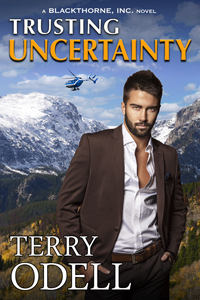 Available Now Trusting Uncertainty, Book 10 in the Blackthorne, Inc. series.
Available Now Trusting Uncertainty, Book 10 in the Blackthorne, Inc. series.
You can’t go back and fix the past. Moving on means moving forward.
Terry Odell is an award-winning author of Mystery and Romantic Suspense, although she prefers to think of them all as “Mysteries with Relationships.” Follow her on Facebook and Twitter.

Photo credit: JohnPotter Pixabay
By Debbie Burke
Why does a writer choose to tell a story from a particular point of view?
Recently, Chuck, a regular TKZ reader, emailed me with questions about omniscient point of view. He wanted to write the first chapter of his revenge-theme murder mystery from the omniscient POV.
Right away, I knew I wasn’t qualified to advise him. I’ve never written anything omniscient. The books I read rarely use it because my personal taste has always favored close, intimate POVs.
So I dove down the research rabbit hole to learn more about this mysterious POV.
Masterclass.com offers this definition:
An omniscient narrator is all-seeing and all-knowing…The narrator may occasionally access the consciousness of a few or many different characters.
Some writers use this perspective to create a more “godlike” or deliberately “authorial” persona that allows them to comment on the action with the benefit of distance.
Before TV, films, internet, and streaming, most people didn’t venture far from the places they were born. Travel was the domain of the wealthy.
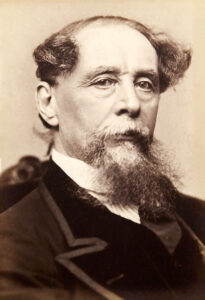
Charles Dickens – Wikimedia
Therefore, books were ships that carried readers to distant shores they would never personally set foot on; to exotic worlds constructed from the author’s descriptions; to smells, sights, sounds, textures, and tastes readers could only imagine.
World building was crucial.

Leo Tolstoy – CC BY-SA 3.0
Authors like Dickens, Tolstoy, and Tolkien spent many pages explaining the physical, social, religious, economic, historic, and psychological elements of the story world.

J.R.R. Tolkien – public domain
But as communication increased and the world became smaller, authors no longer had to paint such detailed pictures.
Reader interest shifted to characters who were fascinating or with whom readers could identify. They wanted go deeper into the characters’ hearts and minds to vicariously experience their fears, elation, rage, joy, doubt, guilt, pride, disappointment, lust, etc.
In today’s book market, close third and first person POVs are the most prevalent, although epic fantasy with its detailed world building still uses omniscient POV.
According to a 2016 New York Times article by Elliott Holt:
The effects of omniscience are authority and scope; novels with such narrators seem especially confident. The characters may be uncertain, but we sense the controlling force above them. Omniscience reinforces that we are reading fiction.
Some readers like that quality while others see it as authorial intrusion.
Holt goes on to say:
We know we’re being watched, by traffic and security cameras, by our employers, by the N.S.A., by random people taking pictures with their phones. We’re aware of the threat of hackers and cybercrime…Technological transcendence is “spooky”: Perhaps omniscience taps into this collective fear about loss of privacy.
Hmm. That explains why I personally avoid omniscient POV.
The most comprehensive article I found about omniscient POV is by John Matthew Fox of Book Fox at this link.
John provides clear, understandable explanations. For instance, in discussing show vs. tell, he says:
Third person omniscient is often more telling than showing, because the narrator is an objective observer. It’s like you’re telling someone about a movie you just saw.
He defines two types of third-person omniscient POV:
Objective: The narrator knows all, but they’re an observer. They can’t get into the characters’ heads, but are telling the story from somewhere outside.
Subjective: The narrator is an observer with opinions. We get a sense of what the narrator thinks about every character, in a judgy kind of way.
He says one advantage is the narrator “can dispense information that no character knows.” But he cautions: “many writers slide over into head hopping.”
He goes on to elaborate:
Where this gets confusing, especially for new writers, is in third person omniscient. Some newer writers think that head hopping and third person omniscient are the same thing, or at least close. This is not true. Third person omniscient tells a story from one perspective: the narrator’s. The narrator shouldn’t tell us the thoughts and feelings of all the characters, or any of the characters.
The narrator shows us how the characters feel through action and dialogue, not by hopping into the character’s heads to reveal what they’re thinking. The story is told from the narrator’s perspective, like the narrator is a character.
Here is John’s most compelling argument against using omniscient POV:
Literary agents and publishers are so reluctant to consider third person omniscient, and they’re not going to do it for a new writer. If you really want to try third person omniscient, do it for a very limited time, like the first chapter, to describe the setting. Sort of like a wide shot in a movie, writing the first chapter in third person omniscient can work.
~~~
As writers, we like to experiment with new ways to tell stories. Some experiments work, others fall flat, and a few explode in our faces.
After researching, my suggestions to Chuck are:
Examine your motive for using omniscient. Why is it the absolute best way to introduce your story? If it’s merely a gimmick or experiment, rethink the choice.
Run the first chapter by critiquers and beta readers. They’ll help you judge if it works or not.
Before submitting to agents or editors, understand that many are predisposed to dislike it.
If you use omniscient POV, be darn sure it’s done correctly and effectively.
~~~
TKZers: Please share books you’ve read that use omniscient POV. Which work and which don’t?
Why do you like or dislike omniscient POV?
~~~
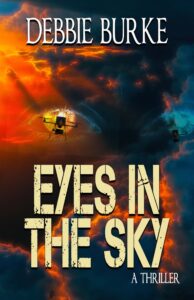
In Debbie Burke’s thriller Eyes in the Sky, a drone gives an omniscient–and sinister–point of view. Please check it out at these links:
by James Scott Bell
@jamesscottbell
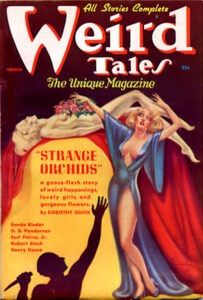 As you know, I’m a fan of the old pulp magazines. They sold like hotcakes to a reading public that wanted their stories fast and entertaining. The key to sales of these mags was, first, an attention-grabbing cover. Since men were the primary readers, tough guys and fetching femmes were prominently featured. The imaginative Weird Tales, for example, specialized in scantily-clad women from other worlds.
As you know, I’m a fan of the old pulp magazines. They sold like hotcakes to a reading public that wanted their stories fast and entertaining. The key to sales of these mags was, first, an attention-grabbing cover. Since men were the primary readers, tough guys and fetching femmes were prominently featured. The imaginative Weird Tales, for example, specialized in scantily-clad women from other worlds.
Then it was up to the story titles and/or author names to close the sale. An intriguing title like Murder in the Ring or a popular name like Gardner, Chandler, Hammett, or Ballard would incentivize the buyer to part with two bits.
In the 1950s, covers got steamier. A trendsetter in this regard was Confidential Detective. The stories inside, accompanied by photos, were nonfiction (“Every Story True!” the cover blared). But the selling principle was the same. Grab with a cover, entice with a title and a blurb.
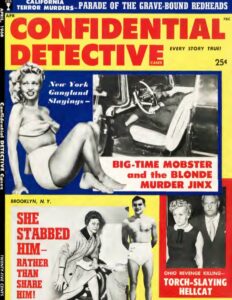 Check out this cover from April, 1960. Alluring blonde prominently featured. Titles appealing to our insatiable curiosity about the criminal mind, especially with a sex angle.
Check out this cover from April, 1960. Alluring blonde prominently featured. Titles appealing to our insatiable curiosity about the criminal mind, especially with a sex angle.
The table of contents for this issue had the following blurbs:
BIG-TIME MOBSTER AND THE BLONDE MURDER JINX
She was a gorgeous bundle of hard luck—especially to racket bosses and Murder, Inc. hoods. But Little Augie wasn’t scared—till the night her jinx worked on him.
SHE STABBED HIM—RATHER THAN SHARE HIM!
With a swift motion, she drove the knife into his chest—up to the handle. Then she yanked the phone from his hand and yelled to the blonde at the other end: “Listen to him moan…I killed him!”
BACK-DOOR LOVER’S DOUBLE-DEATH REVENGE!
Behind every blind in town, and in every bar—there were whispers about the judge’s pretty wife. Then, one night the gossip was confirmed—in bullets and in blood…
TORCH-SLAYING HELLCAT
The fire that ate her love rival’s body roared for hours, but it didn’t consume all the evidence of the blonde’s furious passions.
PARADE OF THE GRAVE-BOUND REDHEADS
One by one, Frankie promised his girls the moon—love, marriage…But when they tried to collect, he paid them off—in cold murder.
JEALOUS FURY KILLS THE NIGHT-CLUB HOSTESS
“Put down the gun,” she begged. “I’ll never, never look at another guy…”
“THE DAMES ALL DIE FOR ME!”
The startling story of a first-class heel who used lies, bigamy, even murder to keep his women in line.
There were marketing people for these mags whose main task was to come up with what I call “power blurbs.” What a job! Come into the office in Manhattan and hammer out a few headlines. Grab a three-martini lunch. Come back to the office, nap, write the subheads.
And it got me to thinking, what if I were tasked to come up with similar allurements for some famous novels? How would I entice the browser to make the purchase? Eschewing the martinis, I knocked out a few:
The Silence of the Lambs
“HE ATE A CENSUS TAKER FOR DINNER—AND I DON’T LIKE THE WAY HE’S LOOKING AT ME!”
The brilliant psychiatrist with a yen for human flesh tried to outfox a young FBI trainee who was haunted by dreams of slaughtered lambs. Was there any hope for this couple?
The Old Man and the Sea
MAN-EATING SHARKS SURROUNDED HIS BOAT—AND DEMANDED TO BE FED!
He was just a little old fisherman with the catch of a lifetime—but jaws of death weren’t going to let him keep it!
The Great Gatsby
OBSESSED WITH ANOTHER MAN’S WIFE!
“She’s mine, Old Sport,” he told his friend. “And I mean to get her back!”
1984
“THEY SAY HE’S MY BIG BROTHER, BUT HE WANTS TO MAKE ME HIS SLAVE!”
He thought two plus two made four—until they messed with his mind.
Then I gave it a whirl with one of my own:
Romeo’s Rules
THE BAD GUYS BET THEY COULD KILL HIM—SO HE MADE THEM PAY!
“I was tied up. My hands behind me. I was in a semi-fetal position on a hard floor. That’s when I got mad.”
It seems to me that writing out a power blurb can really help you nail the selling point of your novel. If you do this early in your writing it will keep you focused as you create your scenes. Or it can be used as a laser beam when it comes time to edit a first draft. Heck, you might even use it as the lead for your book description on Amazon. Why not? “WE WANT TO SELL BOOKS,” SAID THE AUTHORS GATHERED AT THE BAR. And they were willing to do just about anything to do it!
Anyway, it’s fun. Why don’t you try it? Give us a power blurb for a famous novel. Or one of your own if you like. Make us part with two bits!
by Steve Hooley

I love wood—growing trees, harvesting lumber, cutting firewood, making things out of wood. There’s no official name for a lover of wood, but someone proposed “lignophile” (ligno – Latin for wood + phile – Greek for love). That would be me.
I grew up in rural Ohio in a house on a wooded lot. As a boy, I roamed the woods, built a treehouse, mowed the trails, and repaired the fences. I didn’t realize how much my early years had affected me until I finished college and got married.
Being the typical newlywed with very little income, a family to provide for, and free furniture sitting on every curb for anyone to take, I began hauling old furniture home to my garage and repairing it. The style of our house was “early marriage.”
After a few years of doing this, I became interested in building my own furniture and began collecting tools. When I returned to my home community after medical school and residency, I began heating our house with firewood, cut, split, hauled, and stacked from the family woods.
Fast forward forty years, and I purchased the family property (house and 28-acre woods) from my parents. My wife and I now live in my enchanted forest, where I continue to be terminally afflicted with lignophilia.
We heat our house in the winter with firewood harvested during September and October. It is hard work, my wife continues to remind me, and we are getting older. But I enjoy keeping the house a toasty 74 degrees while the wind is blowing and the temperature outside dips below freezing. A heating bill of zero is a nice bonus.
I am always looking for easier ways to handle the firewood. We burn 8-9 cords a winter. That’s a lot of wood. And this year, because of above-average rain with soft soil and several windstorms, we’ve had five large trees blow down in our yard and on the forest trails, extra wood to cut, split, and stack.
I’ve cut up those trees into firewood, but I’m running out of places to stack it. And that introduces the topic of this post, experimentation and trying new ideas. I hate the extra time it takes to build an end to a wood stack (a crisscrossed, log-cabin-style, wood column). I’m eventually going to burn it, and then I have to build another one. What a waste of time. So, this year, I stacked the extra wood between trees. But I’m running out of trees in the wood-storage area.
And that’s when I tried a colossal, stupid experiment. I didn’t want to build any ends to brace the stack, so I thought, “Why not build the stack in a big circle? No ends, right?” So, I tried it.
Well, the stack reached about two feet. Because the circumference of the outside circle (created by the ends of the wood farther from the center) was greater than the inside circle (created by the ends of the wood closer to the center), the outer end of wood pieces dropped into gaps, and the pile started to lean.
Being a fan of experimentation, I was too stubborn to start over. “Let’s see what we can learn from “our mistake.” (I had now pulled my wife into my insane plot.) I began gradually moving subsequent layers in toward the center of the circle as I stacked higher to compensate for the leaning. Now my stack was starting to look like an igloo.
No, we couldn’t junk the idea and start over. We needed to finish what we started, learn any more lessons that could be gleaned from “our experiment.” So, we labored on.
The pile survived at 4-5 feet high without falling. We’ll see if it withstands the winter winds. The Roman arch is supposed to be a strong design element, right?
I was just beginning to close the circle, when my wife said, “How are you going to get inside the circle to put the tarp on and off the wood?”
Oh, yeah, I hadn’t thought of that. I should have put in two posts (creating an entry into the circle) that the pile could lean against on either side. But I might as well have dug a post hole at either end of a long straight pile, and I was too lazy for that. That was the whole purpose, to save time, right? And then another idea hit me. I could put in an open box structure—open on both ends to walk through, no digging required—so the wood could be stacked against both sides, supporting itself, and I would have a doorway into my magic garden.
My wife groaned. We left a “dip” in our pile at about two feet high so I could climb over it. I might yet build that box, maybe, unless I get another idea.
Bottom line, my genius circle of success, turned out to be a giant dome-shaped debacle. But…I had not given up. I stuck with my junker, wacky idea all the way to the bloody end, “learning” from my mistakes. Or as the politicians say when they’ve created a disaster, “We must investigate this, so we can prevent this failure in the future.” Right.
So, now to you, TKZ community. How far down the road that’s not working do you drive your clunker of an idea before you abandon it and scurry off to the new manuscript lot? Do you hang in there, try to repair the clunker, and see what you might learn from a “failed experiment?” Or, do you quickly trade in the old beast for a shiny new one?
Tell us about one of your “failed” experiments. Catharsis is good for the soul.

Top left is Ann Hawkins of John Hawkins & Associates. Center bottom is my editor, Michaela Hamilton of Kensington Publishing.
I don’t think I’ve posted this here already, but if so, it’s probably worth another look from people who are interested in an insider’s view of the traditional publishing game. In this video from my YouTube channel, I sat down with Anne Hawkins, my agent, and Michaela Hamilton, my longtime editor at Kensington Books to get industry professionals’ views on the kinds of topics that are often discussed here on The Killzone.
I thought it was a bit of a coup to get everyone together at once, so the video is admittedly a bit long, but I also think it’s well worth the time. If you want to jump around, here are links to the individual topics:
00:00 Introduction
02:00 Do editors and agents work well together?
04:09 Managing author expectations
05:16 Do publishers nurture new authors?
08:33 The slush pile: What happens with unsolicited manuscripts?
10:16 Do authors need agents?
10:53 Deal points: the author’s advance is only one consideration
12:53 Deal breakers, clients from hell, & you’ve got to do your research
16:12 Traditional publishing is starving for new writers
19:09 What it means for an author to have a platform?
23:20 Are conferences important?
I hope you find something useful in the video. If nothing else, you can watch really great people hanging out with me.